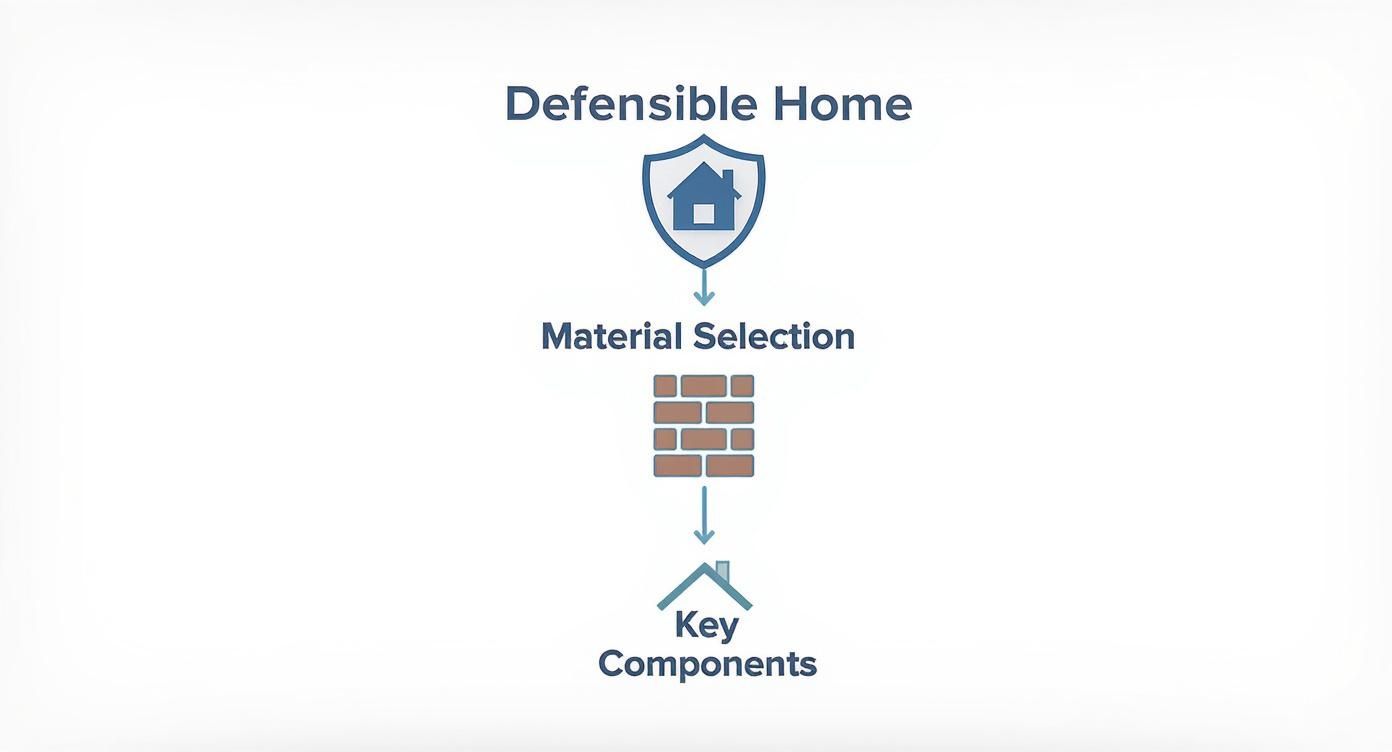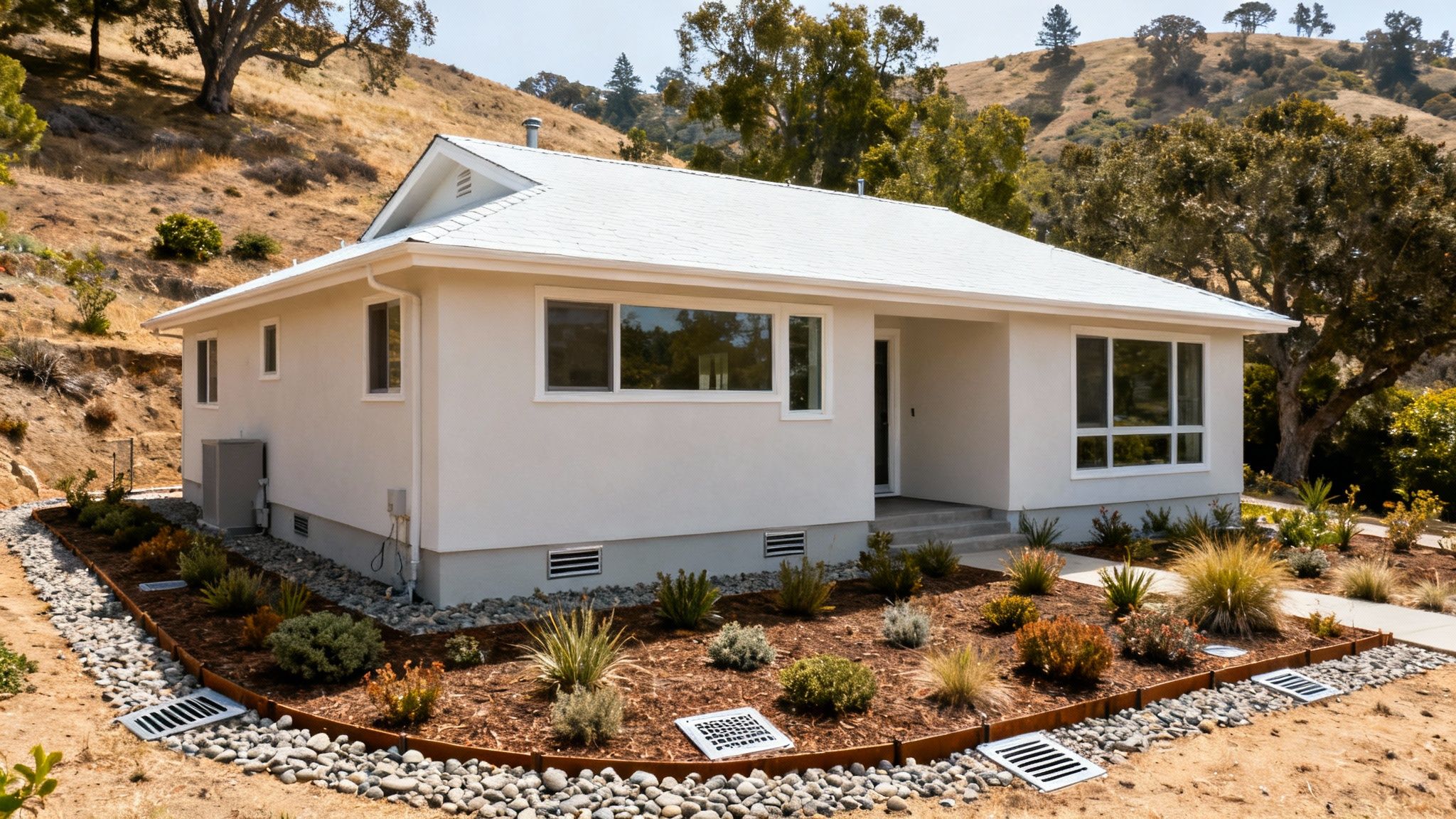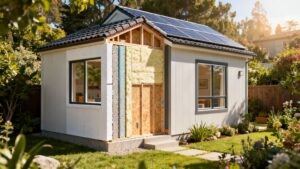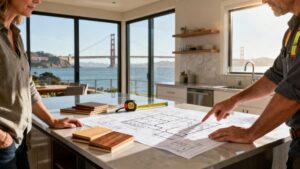Building a home in a Wildland-Urban Interface (WUI) zone means choosing the right materials is your first line of defense. For builders and homeowners in the Bay Area, creating a defensible home starts with fire-resistant roofing, siding, and windows. This guide breaks down what you need to know.
Building a Defensible Home in the Bay Area
Living in the beautiful hills of Berkeley and Oakland comes with a special responsibility: understanding the Wildland-Urban Interface (WUI). The WUI is any area where homes meet undeveloped wildland. This location puts buildings at a higher risk during a wildfire.
As Bay Area communities expand, so does this interface. Fire-safe construction is now a critical priority for builders, architects, and homeowners. It’s about protecting properties and ensuring peace of mind.
What is a Defensible Home?
A defensible home is built to resist wildfire threats. It goes beyond minimum building codes to create a structure hardened against ignition. Most homes lost in wildfires are not destroyed by a wall of flames, but by wind-blown embers that find a weak spot.
The goal is to harden the home's exterior so embers have nowhere to land and ignite. This strategy is built on a few key principles:
- Ignition-Resistant Materials: Using roofing, siding, and decking that won’t easily catch fire.
- Hardened Openings: Securing windows, doors, and vents to block embers from getting inside.
- Defensible Space: Managing the landscape around the home to remove fuel for a fire.
This approach shows how a defensible home starts with the materials you choose for its most important parts.
Key Parts of a Fire-Resistant Home Exterior
This table gives a quick overview of where to focus your efforts. These are the key components of a fire-resistant home.
| Building Component | Primary Goal | Common Fire-Safe Materials |
|---|---|---|
| Roofing | Prevent ember ignition on the home's most exposed surface. | Class A materials like metal, slate, concrete tile, asphalt shingles. |
| Siding | Create a non-combustible building "skin." | Fiber cement, stucco, treated engineered wood, brick/stone. |
| Decking | Reduce the risk of fire spreading from the ground to the house. | Composites, tropical hardwoods (Ipe), non-combustible materials. |
| Windows & Doors | Block radiant heat and prevent ember entry. | Tempered dual-pane glass, metal or fiberglass frames. |
| Vents | Allow airflow but keep embers out. | Fine metal mesh screens (1/8-inch or smaller), baffled vents. |
The right materials form a protective shield around your home. This shield hardens it against the main threats of a wildfire.

As the infographic shows, your roof and walls are the foundation of your defense. They are the largest and most exposed surfaces of your home.
Creating Defensible Space
What you do with the landscape around your home is just as important as the structure itself. Establishing defensible space means managing plants and other fuel sources. Clearing away dry brush and using non-combustible materials like gravel are great first steps.
For larger properties, this landowner's guide to forestry mulching offers techniques for reducing flammable vegetation. For specific product guidance, our guide on sourcing quality lumber in the East Bay is a great resource. This knowledge helps you navigate WUI construction with confidence.
Choosing Fire-Resistant Roofing and Siding

When building a home that can survive a wildfire, the roof and siding are your armor. They are the two largest surfaces and take the most abuse from embers. Choosing the right materials here is the most important decision for a WUI project.
Across the United States, about one-third of all homes are at risk from wildfires. This makes specifying strong, fire-resistant materials a professional responsibility for builders and architects in the Bay Area.
The Gold Standard: Class A Fire-Rated Roofing
In high-risk WUI zones like the Berkeley and Oakland hills, a Class A fire rating for your roof is required. This is the highest rating possible. It means the material can withstand severe fire exposure without catching fire.
Imagine a storm of tiny, burning embers landing on your house. A Class A roof is designed so those embers simply burn out without igniting the structure.
Here are the top choices for Class A roofing materials we recommend for Bay Area projects:
- Metal Roofing: These roofs are tough, non-combustible, and shed leaves and needles easily. Their modern look is a great fit for Bay Area architecture.
- Clay or Concrete Tile: These materials are fireproof and last for a very long time. They are heavy, so the home’s structure must be designed to support the weight.
- Asphalt Shingles (Class A-Rated): Modern asphalt shingles are made with a fiberglass mat, making them highly fire-resistant. They are a cost-effective way to get a Class A rating.
- Composite Materials: Newer composite tiles can look like natural slate or wood but are engineered for better fire performance. They balance looks, safety, and durability.
Selecting Ignition-Resistant Siding
If the roof is the home’s helmet, the siding is its armor. It protects the walls from intense heat and direct flames. Today, builders have great fire-resistant options that are both safe and stylish.
For projects in the Bay Area, choosing the right siding is key. Here are the leading options that we at Truitt & White recommend for WUI construction:
- Fiber Cement Siding: This is one of our most popular materials. Made from sand, cement, and cellulose fibers, it’s non-combustible and durable. It can look just like wood, giving architects design flexibility.
- Stucco: A classic choice for California homes, stucco is extremely fire-resistant. It creates a seamless exterior that helps keep embers out.
- Treated Wood Siding: For clients who love the natural look of wood, there are safe options. You can find excellent fire resistant wood siding options that are treated with fire-retardant chemicals.
- Brick and Stone Veneer: These materials offer the highest level of fire protection because they are completely non-combustible. We often see them used on the lower portion of walls to create a fire-safe zone near the ground.
By starting with Class A roofing and ignition-resistant siding, you create a strong building envelope. This is the foundation of a home built to withstand a wildfire.
Securing Your Home's Openings
Wildfires often find an easy way into a home through weak points like windows, doors, and vents. These openings can act as an invitation for heat and embers. Hardening these entry points is a crucial step in WUI construction.
A fire-resistant home is only as strong as its weakest link. Radiant heat can shatter standard glass, while embers can slip through tiny gaps. Sealing these pathways is essential to protect the entire structure.
Fortifying Windows Against Heat and Embers
Windows are one of the most critical areas to address. A single-pane window offers little resistance to a wildfire's intense heat. The glass can break in minutes, letting embers flood the home.
To prevent this, WUI building codes require dual-pane windows. At least one of the panes must be tempered glass. Tempered glass is about four times stronger than standard glass and is much more likely to stay intact.
The window frame material is also important.
- Fire-Resistant Frames: Choose frames made from materials that won't easily melt, like metal, fiberglass, or reinforced vinyl.
- Proper Installation: Ensure windows are installed correctly with high-quality weatherstripping to create a tight seal against embers.
For builders in the Bay Area, it's vital to select products designed for our climate. Learn more about choosing all-weather windows built to withstand Bay Area conditions in our detailed guide.
The Critical Role of Fire-Rated Doors
Your home's exterior doors are another key defense point. A hollow-core door can burn through quickly. In a WUI zone, every exterior door should be a fire-rated assembly with a solid core.
Solid-core wood, fiberglass, or metal doors provide a much stronger barrier against heat and flames. Just like with windows, a tight seal is critical. Ensure all exterior doors have weatherstripping and a threshold that seals the gap at the bottom.
Sealing Vents The Smart Way
Vents are necessary for airflow, but they can be an open highway for embers. In fact, unprotected vents are one of the most common ways homes catch fire during a wildfire. Modern solutions offer excellent protection.
The WUI standard is to cover all vent openings with a metal screen with openings no larger than 1/8-inch. This fine mesh blocks most embers while still allowing air to circulate. For even greater protection, builders can use modern intumescent vents, which swell up when exposed to heat to completely seal the opening.
The team at Truitt & White can help you navigate product selection for your project. By securing windows, doors, and vents, you significantly harden your home against wildfire threats.
Constructing Fire-Resistant Decks and Outdoor Spaces
An attached deck built with flammable materials can act like a fuse in a wildfire. It can carry fire straight to the house. This makes smart deck construction a critical part of any WUI zone project.
For builders and homeowners in the Bay Area hills, creating a fire-safe outdoor space is essential for safety and code compliance. The right materials can turn a vulnerability into a strong, defensible part of the home.
Choosing WUI-Compliant Decking Materials
The surface of your deck is its most exposed part, so choosing a fire-resistant material is the first step. Modern options deliver great fire performance without sacrificing looks.
Here are the top material choices for a fire-safe deck:
- Composite Decking: Many high-performance composite and PVC decking options have a Class A Flame Spread Rating. They are approved for use in WUI zones. You can learn more about the assortment of Trex decking we carry.
- Naturally Resilient Hardwoods: Certain dense tropical hardwoods, like Ipe, are naturally resistant to ignition. They offer the beauty of real wood with a much higher degree of safety.
- Non-Combustible Materials: For the highest level of fire protection, nothing beats materials like stone pavers, concrete, or tile.
Comparison of WUI-Compliant Decking Materials
| Material Type | Fire-Resistance Level | Maintenance Needs | Relative Cost |
|---|---|---|---|
| Composite (PVC/Capped) | Excellent (Class A Rated) | Low (soap & water cleaning) | High |
| Ipe Hardwood | Very Good (Class A/B) | Medium (annual oiling to preserve color) | Very High |
| Redwood (Fire-Retardant-Treated) | Good (Class B) | High (regular sealing/staining) | Medium-High |
| Stone Pavers / Concrete | Superior (Non-Combustible) | Very Low (occasional cleaning) | High (Varies) |
Each material offers a different balance of cost, looks, and upkeep. All of these options provide a solid foundation for a safer outdoor space.
Best Practices for WUI Deck Construction
Proper design and maintenance are just as important as your material choices. Even the best fire-resistant deck can become a hazard if it’s not built and maintained correctly. The stakes are getting higher every year, according to a detailed government wildfire report.
To ensure your deck is truly defensible, follow these essential best practices:
- Create a Non-Combustible Zone: The area directly under and around the deck must be free of anything that can burn. Clear away leaves and use gravel or pavers to create an ember-proof zone.
- Enclose the Underside: To stop embers from blowing underneath the deck, enclose the perimeter. Use a non-combustible material or a fine metal mesh (1/8-inch openings).
- Ensure Proper Board Spacing: Follow the manufacturer's guidelines for board spacing. This allows for drainage and makes it easier to clean out flammable debris.
By combining fire-resistant materials with smart construction techniques, you can build a beautiful, safe outdoor living space.
Adding Fire-Smart Finishing Touches

True fire resilience is a complete system where small details matter. Once you’ve hardened your roof, siding, and openings, the final step is to address finishing touches. This includes gutters, fences, and landscaping, which complete the home's protective shield.
A home with fire-resistant siding is still at risk if a flammable wooden fence is attached to it. These final details are about eliminating weak links. This approach ensures every part of your property contributes to its safety.
Managing Debris with Smart Gutter Systems
Gutters are designed to catch water, but they also collect dry leaves, pine needles, and twigs. During a wildfire, this pile of kindling is a perfect spot for embers to land.
The fix is a two-part system. First, your gutters should be made from a non-combustible material like steel or aluminum. Second, protect them with high-quality gutter guards. These metal screens let water through while keeping flammable debris out.
Building Safer Fences in High-Risk Zones
A fence attached to a house can act like a wick, carrying fire directly to your exterior walls. This is especially true for traditional wood fences. Smart design and material choices are essential.
Here are the best practices for WUI fencing:
- Create a Disconnect: Never attach a flammable fence directly to the house.
- Use Non-Combustible Materials: For the first five feet of fencing extending from the house, use non-combustible materials like metal or masonry.
- Consider an Open Design: Fences made with metal tubes or wire mesh are less likely to trap debris, which reduces the fuel load near your home.
This five-foot buffer zone is a simple but powerful strategy. It helps ensure a potential fence fire never reaches your home.
Landscaping for Defensible Space
The final piece of the puzzle is your landscaping. The goal is to create defensible space—an area around your home managed to reduce fire danger. It all starts with the five-foot zone immediately surrounding your foundation.
This "non-combustible zone" is critical. Clear out all flammable vegetation, wood mulch, and stored items. Replace them with hardscaping like gravel or pavers. This creates a clean, ember-resistant perimeter around your home.
Your Partner in Bay Area WUI Construction
Building a fire-safe home in the Bay Area is achievable with the right materials and knowledge. While this guide provides a solid foundation for WUI zone construction, we know every project has unique challenges. That's where personalized support makes all the difference.
Navigating local building codes and material specs can be difficult. The wrong product choice can lead to delays and compromise safety. A reliable partner is essential.
Expert Guidance for Your Project
Our team at Truitt & White understands Bay Area WUI regulations. We offer consultations for builders, architects, and homeowners. We help you select materials that meet code and fit your design vision.
We believe building safely in high-risk areas is a team effort. Our specialists help you turn complex code requirements into a practical material list. This saves you time and gives you peace of mind. There are many reasons locals trust our Berkeley hardware store with their most critical projects.
Visit our Berkeley showroom to explore our fire-rated products or connect with a materials specialist for advice tailored to your job. Let's work together to make sure your project is safe, compliant, and built right.
Frequently Asked Questions About WUI Construction
1. What is a Class A fire rating and why is it important?
A Class A fire rating is the highest level of fire resistance for roofing materials. It is critical in WUI zones because your roof is the most vulnerable surface to flying embers. A Class A roof helps prevent these embers from igniting your home.
2. Can I still use wood siding in a WUI zone?
Yes, but it must be fire-retardant-treated (FRT) wood siding. These products are chemically treated to resist ignition and meet strict WUI building codes. This allows you to have the natural look of wood without sacrificing safety.
3. Do I need to replace all my windows to be fire-safe?
Not always, but upgrading windows is a powerful retrofit. The most important features are dual-pane windows with at least one pane made of tempered glass. If you have old single-pane windows, replacing them is a high priority.
4. What is the most important first step to making a home more fire-resistant?
The most critical first step is creating defensible space, starting with the first five feet around your home. This area should be a "non-combustible zone" with materials like gravel or pavers. After that, ensuring you have a Class A-rated roof is the most important structural upgrade.
5. How far should flammable plants be from my house?
Experts recommend creating zones. The first 0-5 feet from your home should be completely free of flammable plants and mulch. In the 5-30 foot zone, use well-irrigated, fire-resistant plants with space between them.
For personalized recommendations on the best WUI-compliant materials for your Bay Area project, the expert team at Truitt & White is here to help. Visit our Berkeley showroom or connect with a materials specialist today.









